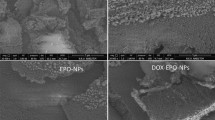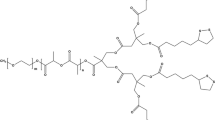Abstract
Supramolecular carriers as a targeted drug delivery system have a significant role in managing the pharmacokinetics and pharmacodynamics of drugs. Therefore, in this project, we used cyclodextrin (CD) as a host molecule for tamoxifen (TMX) and methotrexate (MTX) to evaluate apoptosis mechanism and statistical patterns of release. The flow cytometry analysis showed that combination therapy by anticancer drugs was successful in apoptosis induction compared to free TMX and MTX. Also, real-time PCR and western blot analyses were performed to measure gene expression of Bak1, Bclx, and caspase-3 in estrogen and folate receptor-positive MCF-7 cell lines. All results confirmed that MNPs containing TMX and MTX can significantly increase Bak1/Bclx ratios plus the activity of caspase-3, while free MTX and free TMX showed no effects on triggering apoptosis after 24 h of exposure. According to results of pharmacokinetic studies onto TMX and MTX release, it is revealed that both models that consist of Sahlin-Peppas and Ritger-Peppas create the good fitting curves more than other statistical patterns at both low and high temperatures (37°C and 42°C). For this reason, activation parameters (ΔH‡, ΔS‡, and ΔG‡) were calculated to estimate the favorable model. The lower energy barrier indicates that the Sahlin-Peppas is the favorable model with both diffusion and relaxation process. Therefore, combination therapy by two anticancer drugs, TMX and MTX, utilizing cyclodextrin-based host–guest supramolecular magnetic nanoparticles (CD-MNPs) provided new results for induction of apoptosis and pharmacokinetic model.




Similar content being viewed by others
References
Cheng, H., Fan, X., Wang, X., Ye, E., Loh, X. J., Li, Z., & Wu, Y.-L. (2018). Hierarchically self-assembled supramolecular host–guest delivery system for drug resistant cancer therapy. Biomacromolecules, 19(6), 1926–1938.
Sargazi, A., Azhoogh, M., Allahdad, S., & Heidari Majd, M. (2018). Evaluation of supramolecule conjugated magnetic nanoparticles as a simultaneous carrier for methotrexate and tamoxifen. Journal of Drug Delivery Science and Technology, 47, 115–122. https://doi.org/10.1016/j.jddst.2018.07.006.
Hu, Q.-D., Tang, G.-P., & Chu, P. K. (2014). Cyclodextrin-based host–guest supramolecular nanoparticles for delivery: From design to applications. Accounts of Chemical Research, 47(7), 2017–2025.
Heidari Majd, M., Akbarzadeh, A., & Sargazi, A. (2017). Evaluation of host–guest system to enhance the tamoxifen efficiency. Artificial Cells, Nanomedicine, and Biotechnology, 45(3), 441–447. https://doi.org/10.3109/21691401.2016.1160916.
Gurunathan, S., Kang, M.-H., Qasim, M., & Kim, J.-H. (2018). Nanoparticle-mediated combination therapy: Two-in-one approach for cancer. International Journal of Molecular Sciences, 19(10), 3264. https://doi.org/10.3390/ijms19103264.
Sargazi, A., Kamali, N., Shiri, F., & Heidari Majd, M. (2018). Hyaluronic acid/polyethylene glycol nanoparticles for controlled delivery of mitoxantrone. Artificial Cells, Nanomedicine and Biotechnology, 46(3), 500–509. https://doi.org/10.1080/21691401.2017.1324462.
Din, F. U., Aman, W., Ullah, I., Qureshi, O. S., Mustapha, O., Shafique, S., & Zeb, A. (2017). Effective use of nanocarriers as drug delivery systems for the treatment of selected tumors. International Journal of Nanomedicine, 12, 7291–7309. https://doi.org/10.2147/IJN.S146315.
Saei, A. A., Barzegari, A., Majd, M. H., Asgari, D., & Omidi, Y. (2014). Fe3O4 nanoparticles engineered for plasmid DNA delivery to Escherichia coli. Journal of Nanoparticle Research, 16(8), 2521. https://doi.org/10.1007/s11051-014-2521-0.
Salami, S., & Karami-Tehrani, F. (2003). Biochemical studies of apoptosis induced by tamoxifen in estrogen receptor positive and negative breast cancer cell lines. Clinical Biochemistry, 36(4), 247–253.
Fodor, T., Szántó, M., Abdul-Rahman, O., Nagy, L., Dér, Á., Kiss, B., & Bai, P. (2016). Combined treatment of MCF-7 cells with AICAR and methotrexate, arrests cell cycle and reverses Warburg metabolism through AMP-activated protein kinase (AMPK) and FOXO1. PLoS One, 11(2), e0150232.
Ghodsi, F., Shahraki, M., Habibi-Khorassani, S. M., Omidikia, N., & Heidari Majd, M. (2021). Kinetic modeling on mitoxantrone release from hyaluronic MNP as a drug delivery system. Chemical Methodologies, 5(1), 30–34. https://doi.org/10.22034/chemm.2021.118506.
Mansouri-Torshizi, H., Zareian-Jahromi, S., Ghahghaei, A., Shahraki, S., Khosravi, F., & Heidari Majd, M. (2018). Palladium(II) complexes of biorelevant ligands. Synthesis, structures, cytotoxicity and rich DNA/HSA interaction studies. Journal of Biomolecular Structure and Dynamics, 36(11), 2787–2806. https://doi.org/10.1080/07391102.2017.1372309.
Shahraki, S., Majd, M. H., & Heydari, A. (2019). Novel tetradentate Schiff base zinc(II) complex as a potential antioxidant and cancer chemotherapeutic agent: Insights from the photophysical and computational approach. Journal of Molecular Structure, 1177, 536–544. https://doi.org/10.1016/j.molstruc.2018.10.005.
Shahraki, S., Shiri, F., Heidari Majd, M., & Dahmardeh, S. (2019). Anti-cancer study and whey protein complexation of new lanthanum(III) complex with the aim of achieving bioactive anticancer metal-based drugs. Journal of Biomolecular Structure and Dynamics, 37(8), 2072–2085. https://doi.org/10.1080/07391102.2018.1476266.
Sargazi, A., Shiri, F., Keikha, S., & Majd, M. H. (2018). Hyaluronan magnetic nanoparticle for mitoxantrone delivery toward CD44-positive cancer cells. Colloids and Surfaces B: Biointerfaces, 171, 150–158. https://doi.org/10.1016/j.colsurfb.2018.07.025.
Hashemzaei, M., Barani, A. K., Iranshahi, M., Rezaee, R., Tsarouhas, K., Tsatsakis, A. M., Wilks, M. F., & Tabrizian, K. (2016). Effects of resveratrol on carbon monoxide-induced cardiotoxicity in rats. Environmental Toxicology and Pharmacology, 46, 110–115.
Sargazi, A., Barani, A., & Heidari Majd, M. (2020). Synthesis and apoptotic efficacy of biosynthesized silver nanoparticles using Acacia luciana flower extract in MCF-7 breast cancer cells: Activation of Bak1 and Bclx for cancer therapy. BioNanoScience. https://doi.org/10.1007/s12668-020-00753-x.
Alarifi, S., Ali, H., & Saad Alkahtani, M. S. A. (2017). Regulation of apoptosis through bcl-2/bax proteins expression and DNA damage by nano-sized gadolinium oxide. International Journal of Nanomedicine, 12, 4541. https://doi.org/10.2147/IJN.S139326.
Barar, J., Kafil, V., Majd, M. H., Barzegari, A., Khani, S., Johari-Ahar, M., Asgari, D., Cokous, G., & Omidi, Y. (2015). Multifunctional mitoxantrone-conjugated magnetic nanosystem for targeted therapy of folate receptor-overexpressing malignant cells. Journal of Nanobiotechnology, 13(1). https://doi.org/10.1186/s12951-015-0083-7.
Shrestha, R., & Prajapati, S. (2019). Assessment of prescription pattern and prescription error in outpatient Department at Tertiary Care District Hospital, Central Nepal. Journal of Pharmaceutical Policy and Practice, 12, 16–16. https://doi.org/10.1186/s40545-019-0177-y.
Siepmann, J., & Siepmann, F. (2008). Mathematical modeling of drug delivery. International Journal of Pharmaceutics, 364(2), 328–343. https://doi.org/10.1016/j.ijpharm.2008.09.004.
Puhalla, S., Bhattacharya, S., & Davidson, N. E. (2012). Hormonal therapy in breast cancer: A model disease for the personalization of cancer care. Molecular Oncology, 6(2), 222–236. https://doi.org/10.1016/j.molonc.2012.02.003.
Heidari Majd, M., Asgari, D., Barar, J., Valizadeh, H., Kafil, V., Abadpour, A., Moumivand, E., Mojarrad, J. S., Rashidi, M. R., Coukos, G., & Omidi, Y. (2013). Tamoxifen loaded folic acid armed PEGylated magnetic nanoparticles for targeted imaging and therapy of cancer. Colloids and Surfaces B: Biointerfaces, 106, 117–125. https://doi.org/10.1016/j.colsurfb.2013.01.051.
Yaşar, P., Ayaz, G., User, S. D., Güpür, G., & Muyan, M. (2016). Molecular mechanism of estrogen-estrogen receptor signaling. Reproductive Medicine and Biology, 16(1), 4–20. https://doi.org/10.1002/rmb2.12006.
Ducker, G. S., & Rabinowitz, J. D. (2017). One-carbon metabolism in health and disease. Cell Metabolism, 25(1), 27–42. https://doi.org/10.1016/j.cmet.2016.08.009.
Spurlock III, C. F., Aune, Z. T., Tossberg, J. T., Collins, P. L., Aune, J. P., Huston III, J. W., Crooke, P. S., Olsen, N. J., & Aune, T. M. (2011). Increased sensitivity to apoptosis induced by methotrexate is mediated by JNK. Arthritis and Rheumatism, 63(9), 2606–2616.
Jalali, A., Zafari, J., Jouni, F. J., Abdolmaleki, P., Shirazi, F. H., & Khodayar, M. J. (2019). Combination of static magnetic field and cisplatin in order to reduce drug resistance in cancer cell lines. International Journal of Radiation Biology, 1–8.
Senapati, S., Mahanta, A. K., Kumar, S., & Maiti, P. (2018). Controlled drug delivery vehicles for cancer treatment and their performance. Signal Transduction and Targeted Therapy, 3(1), 7. https://doi.org/10.1038/s41392-017-0004-3.
Blackman, C. F., Benane, S. G., & House DE. (2001). The influence of 1.2 microT, 60 Hz magnetic fields on melatonin- and tamoxifen-induced inhibition of MCF-7 cell growth. Bioelectromagnetics, 22(2), 122–128. https://doi.org/10.1002/1521-186x(200102)22:2<122::aid-bem1015>3.0.co;2-v.
Yuan, Y.-G., & Gurunathan, S. (2017). Combination of graphene oxide–silver nanoparticle nanocomposites and cisplatin enhances apoptosis and autophagy in human cervical cancer cells. International Journal of Nanomedicine, 12, 6537.
Popgeorgiev, N., Jabbour, L., & Gillet, G. (2018). Subcellular localization and dynamics of the Bcl-2 family of proteins. Frontiers in Cell and Development Biology, 6, 13–13. https://doi.org/10.3389/fcell.2018.00013.
Bauer, C., Hees, C., Sterzik, A., Bauernfeind, F., Mak’Anyengo, R., Duewell, P., Lehr, H.-A., Noessner, E., Wank, R., & Trauzold, A. (2015). Proapoptotic and antiapoptotic proteins of the Bcl-2 family regulate sensitivity of pancreatic cancer cells toward gemcitabine and T-cell–mediated cytotoxicity. Journal of Immunotherapy, 38(3), 116–126. https://doi.org/10.1097/CJI.0000000000000073.
Suhaili, S. H., Karimian, H., Stellato, M., Lee, T.-H., & Aguilar, M.-I. (2017). Mitochondrial outer membrane permeabilization: A focus on the role of mitochondrial membrane structural organization. Biophysical Reviews, 9(4), 443–457. https://doi.org/10.1007/s12551-017-0308-0.
Li, W., Shi, X., Xu, Y., Wan, J., Wei, S., & Zhu, R. (2017). Tamoxifen promotes apoptosis and inhibits invasion in estrogen-positive breast cancer MCF-7 cells. Molecular Medicine Reports, 16(1), 478–484.
Sharifi, S., Barar, J., Hejazi, M. S., & Samadi, N. (2015). Doxorubicin changes Bax /Bcl-xL Ratio, caspase-8 and 9 in breast cancer cells. Advanced Pharmaceutical Bulletin, 5(3), 351–359. https://doi.org/10.15171/apb.2015.049.
Cao, X., Hou, J., An, Q., Assaraf, Y. G., & Wang, X. (2020). Towards the overcoming of anticancer drug resistance mediated by p53 mutations. Drug resistance updates: Reviews and commentaries in antimicrobial and anticancer chemotherapy, 49, 100671. https://doi.org/10.1016/j.drup.2019.100671.
Omer, S. A., & Fakhre, N. A. (2019). Three different spectrophotometric methods for simultaneous determination of pyriproxyfen and chlorothalonil residues in cucumber and cabbage samples. Journal of Spectroscopy, 2019, 8241625. https://doi.org/10.1155/2019/8241625.
Dash, S., Murthy, P. N., Nath, L., & Chowdhury, P. (2010). Kinetic modeling on drug release from controlled drug delivery systems. Acta Poloniae Pharmaceutica, 67(3), 217–223
Ritger, P. L., & Peppas, N. A. (1987). A simple equation for description of solute release II. Fickian and anomalous release from swellable devices. Journal of Controlled Release, 5(1), 37–42. https://doi.org/10.1016/0168-3659(87)90035-6.
Giri, B. R., Song, E. S., Kwon, J., Lee, J. H., Park, J. B., & Kim, D. W. (2020). Fabrication of intragastric floating, controlled release 3D printed theophylline tablets using hot-melt extrusion and fused deposition modeling. Pharmaceutics, 12(1). https://doi.org/10.3390/pharmaceutics12010077.
Gull, N., Khan, S. M., Butt, O. M., Islam, A., Shah, A., Jabeen, S., Khan, S. U., Khan, A., Khan, R. U., & Butt, M. T. Z. (2020). Inflammation targeted chitosan-based hydrogel for controlled release of diclofenac sodium. International Journal of Biological Macromolecules, 162, 175–187. https://doi.org/10.1016/j.ijbiomac.2020.06.133.
Higuchi, T. (1963). Mechanism of sustained-action medication. Theoretical analysis of rate of release of solid drugs dispersed in solid matrices. Journal of Pharmaceutical Sciences, 52(12), 1145–1149. https://doi.org/10.1002/jps.2600521210
Hixson, A. W., & Crowell, J. H. (1931). Dependence of reaction velocity upon surface and agitation. Industrial and Engineering Chemistry, 23(8), 923–931. https://doi.org/10.1021/ie50260a018.
Habibi-Khorassani, S. M., Maghsoodlou, M. T., Talaiefar, S., Kazemian, A. M., & Aboonajmi, J. (2014). Full kinetics and a mechanistic investigation of the synthesis of tetrahydrobenzo [b] pyrans in the presence of sodium acetate as a catalyst by a one-pot three-component reaction. Letters in Organic Chemistry, 11(6), 413–421.
Carvalho-Silva, V. H., Coutinho, N. D., & Aquilanti, V. (2019). Temperature dependence of rate processes beyond Arrhenius and Eyring: Activation and transitivity. Frontiers in Chemistry, 7(380). https://doi.org/10.3389/fchem.2019.00380
Lente, G., Fábián, I., & Poë, A. J. (2005). A common misconception about the Eyring equation. New Journal of Chemistry, 29(6), 759–760. https://doi.org/10.1039/B501687H.
Haroon, H., Gardazi, S. M. H., Butt, T. A., Pervez, A., Mahmood, Q., & Bilal, M. (2017). Novel lignocellulosic wastes for comparative adsorption of Cr (VI): Equilibrium kinetics and thermodynamic studies. Polish Journal of Chemical Technology, 19(2), 6–15.
Acknowledgements
The authors thank the Deputy of Research and Technology of Zabol University of Medical Sciences and also Research Council of the University of Sistan and Baluchestan for all the support provided.
Author information
Authors and Affiliations
Corresponding author
Ethics declarations
Conflict of Interest
The authors declare no competing interests.
Research Involving Humans and Animals Statement
None.
Informed Consent
None.
Funding Statement
This research received no specific grant from any funding agency in the public, commercial, or not-for-profit sectors.
Additional information
Publisher’s Note
Springer Nature remains neutral with regard to jurisdictional claims in published maps and institutional affiliations.
Rights and permissions
About this article
Cite this article
Habibi Khorassani, S., Ghodsi, F., Arezomandan, H. et al. In Vitro Apoptosis Evaluation and Kinetic Modeling onto Cyclodextrin-Based Host–Guest Magnetic Nanoparticles Containing Methotrexate and Tamoxifen. BioNanoSci. 11, 667–677 (2021). https://doi.org/10.1007/s12668-021-00877-8
Accepted:
Published:
Issue Date:
DOI: https://doi.org/10.1007/s12668-021-00877-8




